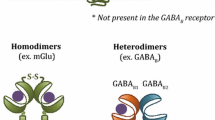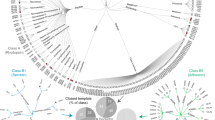Abstract
G-protein-coupled receptors (GPCRs) are a diverse family of integral membrane proteins that are believed to share many structural and functional properties. Upon stimulation, these receptors can transmit a signal across the bilayer that results in the activation of enzymes or transport systems via a G-protein. The size of the family is increasing rapidly and includes the neurotransmitter receptors (e.g., adrenergic, muscarinic acetylcholine, neurokinins, dopamine, serotonin) as well as the visual and odorant receptors (e.g., rhodopsin).
Access this chapter
Tax calculation will be finalised at checkout
Purchases are for personal use only
Preview
Unable to display preview. Download preview PDF.
Similar content being viewed by others
References
Altenbach C, Marti T, Khorana HG, Hubbell WL (1990) Structural studies on transmembrane proteins 2. Spin labeling of bacteriorhodopsin mutants at unique cysteines. Science 248:1088–1092.
Brett M, Findlay JBC (1979) Investigation of the organisation of rhodopsin in sheep photoreceptor membranes using cross-linking agents. Biochem J 117:215–223.
Brett M, Findlay JBC (1983) isolation and characterization of the CNBr peptides from the proteolytically derived N terminal fragment of ovine rhodopsin. Biochem J 211:661–670.
Cornette JL, Cease KB, Margalit H, Spouge JL, Berzofsky JA, DeLisi C (1987) Hydrophobicity scales and computational techniques for detecting amphipathic structures in proteins. J Mol Biol 195:659–685.
Davison MD, Findlay JBC (1986a) Modification of ovine opsin with the photosensitive hydrophobic probe l-azido-4[125I]iodobenzene. Biochem J 234:413–420.
Davison MD, Findlay JBC (1986b) Identification of the sites in opsin modified photoactivated l-azido-4[125I]iodobenzene. Biochem J 236:389–395.
Donnelly D, Johnson MJ, Blundell TL, Saunders J (1989) An analysis of the periodicity of conserved residues in sequence alignments of G-protein coupled receptors. FEBS Lett 251:109–116.
Donnelly D, Overington JP, Ruffle SV, Nugent JHA, Blundell TL (1993) Modelling α-helical transmembrane domains — the calculation and use of substitution tables for lipid facing residues. Protein Sci 2:55–70.
Eisenberg D, Weiss RM, Terwilliger TC (1984) The hydrophobic moment detects periodicity in protein hydrophobicity. Proc Natl Acad Sci USA 81:140–144.
Findlay JBC, Brett M, Pappin DJC (1981) Primary structure of C-terminal functional sites in ovine rhodopsin. Nature 293:314–316.
Findlay JBC, Pappin DJC (1986) The opsin family of proteins. Biochem J 238: 625–642.
Findlay J, Eliopoulos E (1990) Three-dimensional modelling of G protein-linked receptors. TIPS 11:492–499.
Gamier J, Osguthorpe DJ, Robson B (1978) Analysis of the accuracy and implications of simple methods for predicting the secondary structure of globular proteins. J Mol Biol 120:97–120.
Grötzinger J, Engelss M, Jacoby E, Wollmer A, Straßburger W (1991) A model for the C5a receptor and for its interaction with the ligand. Protein Sci 4:767–771.
Henderson R, Unwin PTN (1975) Three-dimensional model of purple membrane obtained by electron microscopy. Nature 257:28–32.
Henderson R, Baldwin JM, Ceska TA, Zemlin F, Beckmann E, Downing KH (1990) Model for the structure of bacteriorhodopsin based on high resolution electron cyro-microscopy. J Mol Biol 213:899–929.
Hibert MF, Trumpp-Kallmeyer S, Bruinvels A, Hoflack J (1991) Three-dimensional models of neurotransmitter G-binding protein-coupled receptors. Molecular Pharmacology 40:8–15.
Karnik SS, Khorana HG (1990) Cysteine residues 110 and 187 are essential for the formation of correct structure in bovine rhodopsin. J Biol Chem 265:17520–17524.
Komiya H, Yeates TO, Rees DC, Allen JP, Feher G (1988) Structure of the reaction centre from Rhodobacter sphaeroides R-26 and 2.4.1: symmetry relations and sequence comparisons between different species. Proc Natl Acad Sci USA 85:9012–9016.
MaloneyHuss K, Lybrand TP (1992) Three-dimensional structure for the β2 adrenergic receptor protein based on computer modeling studies. J Mol Biol 225:859–871.
Ovchinnikov YuA, Abdulaev NG, Bogachuk AS (1988) Two adjacent cysteine residues in the C-terminal cytoplasmic fragment of bovine rhodopsin are palmitylated. FEBS Lett 230:1–5.
Pappin DJC, Eliopoulos E, Brett M, Findlay JBC (1984) A structural model for ovine rhodopsin. Int J Biol Macromol 6:73–76.
Rees DC, DeAntonio L, Eisenberg D (1989) Hydrophobic organization of membrane proteins. Science 245:510–513.
Strader CD, Candelore MR, Hill WS, Sigal IS, Dixon RAF (1989) Identification of two serine residues involved in agonist activation of the β-adrrenergic receptor. J Biol Chem 264:13572–13578.
Strader CD, Gaffney T, Sugg EE, Candlemore MR, Keys R, Patchett AA, Dixon RAF (1991) Allele specific activation of genetically engineered receptors. J Biol Chem 266:5–8.
Stubbs GW, Smith HG, Litman BJ (1976) Alkyl glucosides as effective solubilizing agents for bovine rhodopsin — a comparison of several commonly used detergents. Biochim Biophys Acta 246:46–56.
Sutcliffe MJ, Haneef I, Carney D, Blundeli TL (1987a) Knowledge-based modelling of homologous proteins 1. Three-dimensional frameworks derived from the simultaneous superposition of multiple structures. Prot Engng 1:377–384.
Sutcliffe MJ, Hayes FRF, Blundell TL (1987b) Knowledge-based modelling of homologous proteins 2. Rules for the conformation of substituted sidechains. Prot Engng 1:385–392.
Tadayyon M, Zhang Y, Gnaneshan S, Hunt L, Mehraein-Ghomi F, Broome-Smith JK (1992) β-Lactamase fusion analysis of membrane protein assembly. Biochem Soc Trans 20:598–601.
Wang JK, McDowell JHM, Hargrave PA (1980) Site of attachment of 11-cis-retinal in bovine rhodopsin. Biochem 19:5111–5117.
Wang H-y, Lipfert L, Malbon CC, Bahouth S (1989) Sire-directed anti-peptide antibodies define the topography of the β-adrenergic receptor. J Biol Chem 264:14424–14431.
Editor information
Editors and Affiliations
Rights and permissions
Copyright information
© 1993 Springer-Verlag Berlin Heidelberg
About this chapter
Cite this chapter
Findlay, J.B.C., Donnelly, D. (1993). The Superfamily: Molecular Modelling. In: Dickey, B.F., Birnbaumer, L. (eds) GTPases in Biology II. Handbook of Experimental Pharmacology, vol 108 / 2. Springer, Berlin, Heidelberg. https://doi.org/10.1007/978-3-642-78345-6_2
Download citation
DOI: https://doi.org/10.1007/978-3-642-78345-6_2
Publisher Name: Springer, Berlin, Heidelberg
Print ISBN: 978-3-642-78347-0
Online ISBN: 978-3-642-78345-6
eBook Packages: Springer Book Archive




